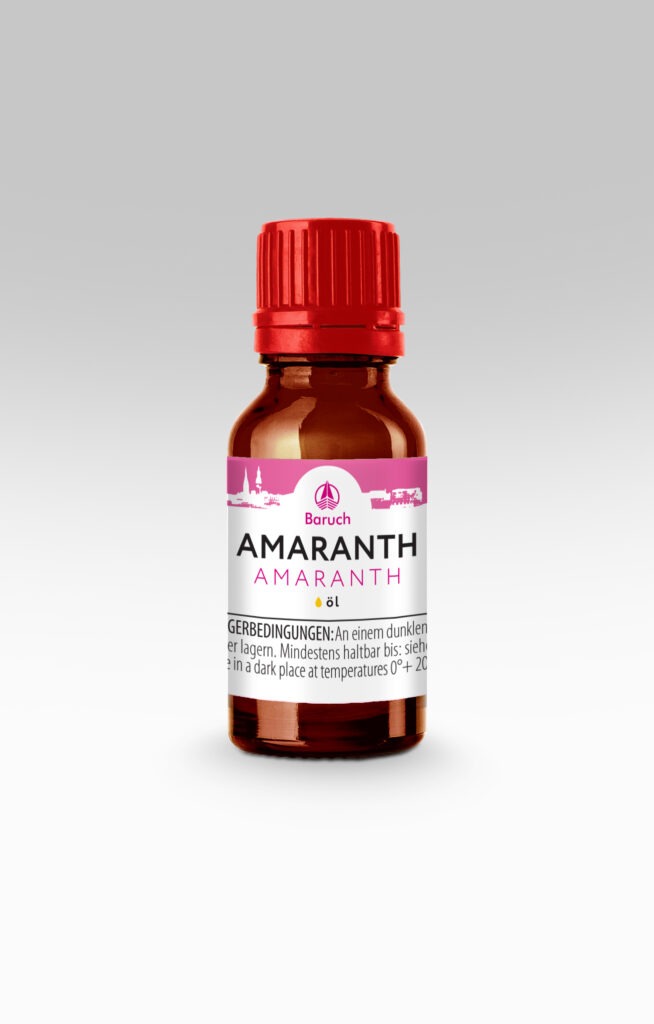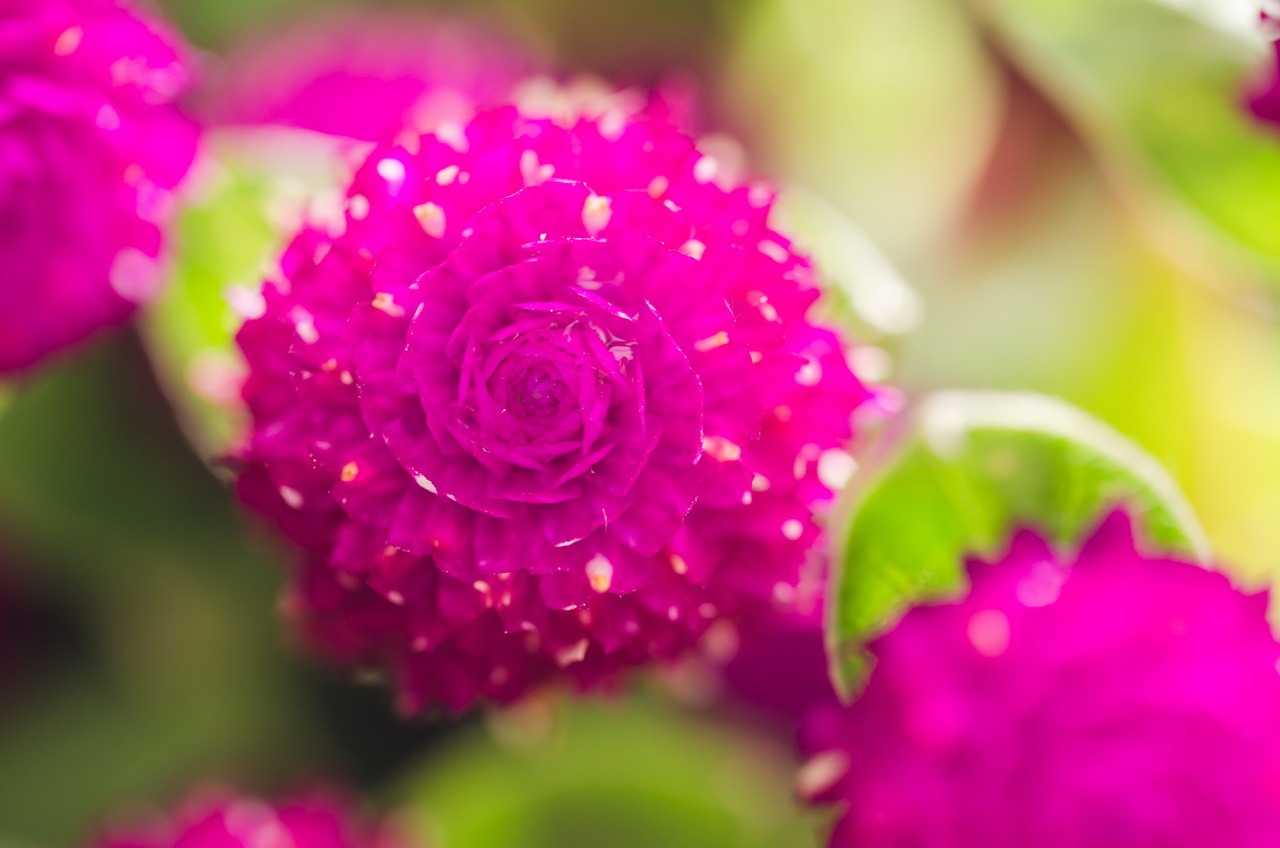Mesoamerica is believed to be the birthplace of the amaranth, while its various cultivars and species (including wild ones) grow around the world. Attitudes towards amaranth were ambivalent – on the one hand, wild amaranth species were always considered to be malicious weeds; on the other hand, they were revered as a valuable feed additive, especially for pigs. In the middle of the 18th century, amaranth was brought to Europe from the countries of Southeast Asia and it was started to be cultivated as a cultural grain.
Currently, the official pharmacopoeia uses amaranth oil as a substance with anti-tumor, wound and ulcer healing and hepatoprotective effects. It is believed that amaranth oil should be used in diseases of the heart and vascular system, diabetes, macular degeneration. Amaranth oil has been shown to be very effective in the treatment of dermatological diseases and traumatic injuries to the skin and mucous membranes.
Amaranth oil has the taste of nuts and can therefore be used in confectionery and in making sauces and salads.
Concentrated 100% CO2 extract from amaranth is an oily liquid of greenish-yellow color with an oily odor and pronounced nut notes. In terms of its biological activity, the CO2 extract of the amaranth is superior to the amaranth oil obtained by cold pressing and even more to the amaranth oil, which is obtained from heat-treated seeds.
The CO2 extract from amaranth is valuable because it contains a lot of squalene, unsaturated fatty acids, fat-soluble vitamins (A, D and E) and a number of other compounds that have a positive effect on the skin condition.


Chart 1. Main components of the amaranth CO2 extract
| NAME | CONTENT IN% OF THE AMOUNT OF VOLATILE COMPONENTS | EFFECT |
|---|---|---|
| Linoleic acid | 53 | An essential, polyunsaturated omega-6 fatty acid that is essential for the functioning of cell membranes |
| Squalene | 22 | Anticarcinogenic, antimicrobial and fungicidal effects. Saturates tissues with oxygen, which helps to rejuvenate them |
| Palmitic acid | 13 | Unsaturated fatty acid for water repellency in cosmetics |
| Beta-carotene (provitamin A) | 3 | Suppresses the production and accumulation of free radicals and reactive oxygen, a powerful immune stimulant. Natural UV filter. In synthetic form, it can cause allergies. Natural dye |
| Tocotrienol (vitamin E) | 2,9 | Maintains the stability of red blood cells, normalizes metabolic processes. An active antioxidant. Prevents thrombophlebitis and the deposition of fatty deposits in the vessels |
| Alpha-pinene | 2 | Easily penetrates the epidermis and irritates the nerve endings, which leads to intense blood circulation. Has an expectorant effect |
| Camphene | 1,8 | Used in the manufacture of camphor and in perfumery. Narrows peripheral blood vessels, improves blood flow to the capillaries |
| Ergocalcisterol (provitamin D2) | 0,8 | Participates in the regulation of cell proliferation, metabolic processes, hormone synthesis, the absorption of calcium and phosphorus by the body |
| Bis (2-ethylhexyl) phthalate | 2,9 | Used in perfumery and cosmetics as an aroma fixer |
More than 30 compounds with biological activity have been identified in the CO2 extract of the amaranth.
In cosmetics, amaranth CO2 extract is valued as an effective addition to creams for the care of dry skin, as well as:
- Additive in creams for mature skin
- moisturizing additive
- Addition in skin care creams
- Additive in skin-softening creams
- antioxidant component
Squalene, which is contained in the CO2 extract of Amaranth, is an active transdermal transporter and promotes the penetration of other biologically active compounds into the inner layers of the skin.
In the food industry, amaranth CO2 extract is most promising as an additive to various functional products. It can also be used as a flavoring to give food a slight nutty flavor.
Chart 2. Application rates, recommendations for the use and storage of amaranth CO2 extract
| Food usage rates | Item А100: 0.005% (50g per ton) Water-soluble microemulsions EMA1: 0.5% (5l per 1000l or 5ml per liter) |
| Application rates in cosmetics | Item А10: 1-3% Item А100: 0.1-0.3% |
| Recommendations for use | It is recommended to add CO2 extracts in the final stages of preparation, in the cooling phase of the end product. |
| Storage Instructions | It is recommended to store CO2 extracts in a closed container in a cool room and avoid direct sunlight. |
Historical reference
In their homeland in Central America (Mesoamerica) as well as in South America, the Indians called amaranth “grain of God”, “wheat of the Aztecs”, “bread of the Incas” and used it as one of the bases of their vegetable diet – amaranth -Grain was second only to corn. However, amaranth was not only used for good causes. It was also an indispensable attribute of various types of religious ceremonies, including the most sinister ones involving human sacrifice.
